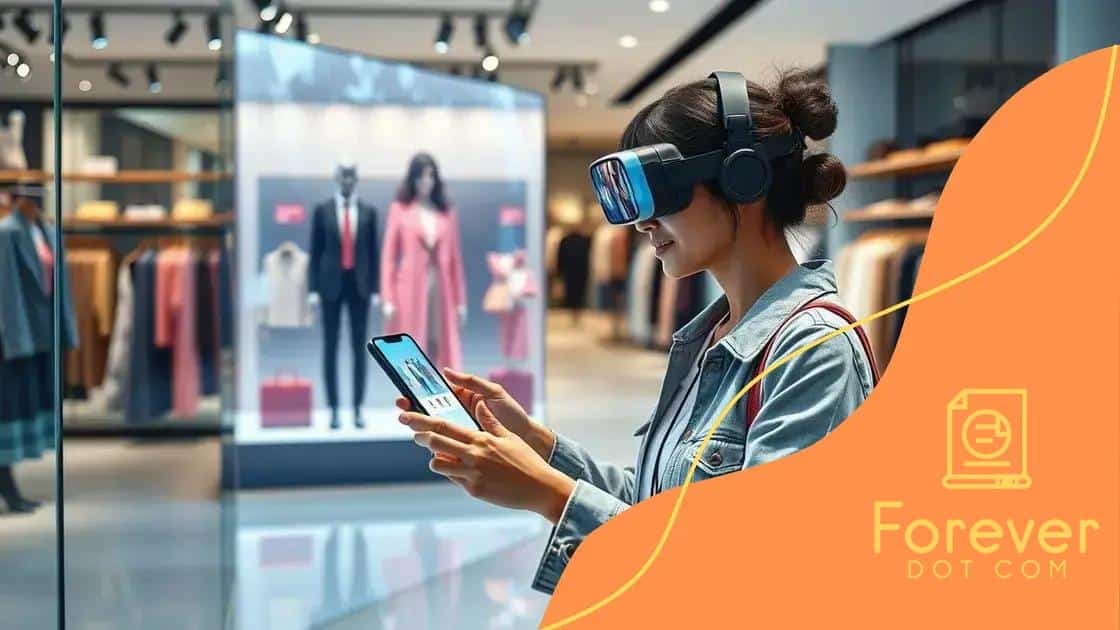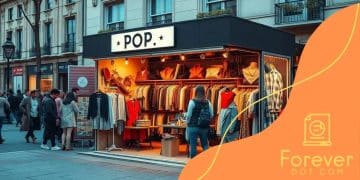Augmented reality in fashion retail experiences

Augmented reality in fashion retail enhances customer experiences by allowing virtual try-ons, increasing personalization, and integrating with social media, ultimately improving engagement and reducing return rates.
Augmented reality in fashion retail experiences is changing how we shop, offering unique solutions to enhance consumer interaction. Have you ever imagined trying on clothes without stepping into a fitting room? This technology opens up possibilities that can truly reshape your shopping adventure.
Understanding augmented reality in fashion
Understanding augmented reality in fashion allows consumers to engage with brands in entirely new ways. This technology blends the physical and digital worlds, creating immersive experiences that enhance the shopping journey.
Redefining Shopping Experiences
With augmented reality, users can see how an outfit looks on them without trying it on. Imagine scrolling through your phone and instantly viewing yourself in a stunning dress!
Key Benefits of Augmented Reality
- Enhanced consumer engagement: Shoppers can interact with products digitally, leading to increased time spent on apps.
- Informed purchasing decisions: Seeing a virtual item on oneself helps reduce return rates.
- Unique marketing strategies: Brands can stand out by offering novel shopping experiences powered by AR technology.
This interactivity not only attracts customers but keeps them coming back for more. As shoppers transition to online platforms, augmented reality serves as a bridge to retain that hands-on feel.
The technology isn’t just about trying on clothes; it also enhances how we visualize products. For example, stores can feature AR mirrors that let customers see how different styles fit in real-time.
Trends in Augmented Reality
As augmented reality continues to evolve, the fashion industry eagerly adopts its innovations. Future trends may include AR-driven personal shoppers, which use data to suggest styles based on individual preferences.
Additionally, integrating AR with social media platforms enables users to share their virtual outfits, fostering community and enhancing brand visibility.
Facing Challenges
Despite its advantages, implementing augmented reality isn’t without challenges. Retailers must ensure that the technology is user-friendly and accessible to all. High-quality graphics are essential for maintaining a seamless experience; otherwise, the technology may not achieve its full potential.
In conclusion, understanding augmented reality in fashion opens doors to a shopping revolution. By merging technology with creativity, brands can offer innovative experiences that resonate with modern consumers.
The impact of augmented reality on customer engagement
The impact of augmented reality on customer engagement is profound and transformative. By combining the real and virtual worlds, brands can create interactive experiences that captivate shoppers.
Increased Customer Interaction
Studies show that customers are more likely to engage with brands that utilize augmented reality. This technology encourages users to spend longer on apps, trying out different clothing styles or accessories in a virtual setting.
Benefits of Augmented Reality
- Boosted brand loyalty: When customers enjoy their experience, they are more likely to return.
- Personalized shopping: AR can tailor experiences based on a customer’s style and preferences.
- Higher conversion rates: Engaging experiences lead to quicker purchase decisions.
Through features like virtual fitting rooms, brands not only enhance the shopping experience but also allow consumers to visualize products better. Imagine being able to see how a pair of shoes would look on your feet without ever leaving your home!
The interaction generated by these technologies builds trust and satisfaction. As customers try on clothes virtually, they feel more confident in their choices, reducing the chances of returns. Retailers benefit from fewer returns and happier customers.
Case Studies
Several brands have successfully implemented AR to improve customer engagement. For instance, a leading cosmetics brand allows users to try on makeup virtually, increasing both engagement and sales. Shoppers can see what products look like on their own skin tones before making a purchase.
Moreover, interactive AR advertisements often draw in more viewers compared to traditional ads. Consumers are intrigued by the opportunity to engage with a brand interactively, creating a lasting impression.
The impact of augmented reality on customer engagement highlights the need for retailers to embrace technology. As users become more reliant on digital interactions, companies that adapt will drive deeper connections and revenue growth.
How augmented reality enhances the shopping experience

Augmented reality significantly enhances the shopping experience by offering interactive and immersive ways for customers to connect with products. With augmented reality, shoppers can visualize how items will look and fit in their real world, transforming the traditional shopping approach.
Virtual Try-Ons
One of the most popular applications of augmented reality is virtual try-ons. Shoppers can see how clothing, accessories, or even makeup will look on them without physically trying anything on. This technology provides a fun and engaging way to explore different styles.
Benefits of Enhanced Interaction
- Improved decision-making: Shoppers can make better choices when they have a clear view of how a product fits their style.
- Reduced return rates: When customers can virtually try products, they are less likely to return them.
- Elevated customer satisfaction: Engaging experiences create happy shoppers who are more likely to return.
In addition to virtual try-ons, augmented reality can also enhance the in-store experience. Imagine walking into a store and pointing your phone at a product, only to see additional information pop up, such as reviews, prices, and suggestions for matching items. This feature makes shopping more informative and enjoyable.
Shoppers are drawn to the novelty and excitement of augmented reality. As customers engage with products in unique ways, they are more likely to share their experiences on social media, which can lead to greater brand visibility and reach.
Creating Personal Connections
Augmented reality also allows brands to create personal connections with customers. For example, one can customize products using AR, tailoring items to individual preferences. This customization elevates the shopping experience and makes customers feel valued.
As augmented reality continues to develop, the possibilities for enhancing the shopping experience are endless. Retailers that embrace this technology not only elevate their services but also improve consumer engagement by creating memorable and meaningful interactions.
Successful examples of augmented reality in retail
There are many successful examples of augmented reality in retail that showcase how this technology can transform the shopping experience. From immersive apps to innovative in-store displays, businesses are leveraging AR to engage consumers.
Sephora Virtual Artist
Sephora’s Virtual Artist app allows customers to try on makeup products using augmented reality. Shoppers can see how different shades of lipstick or eyeshadow look on their skin in real-time. This feature enhances the shopping experience, making it fun and personalized.
IKEA Place
IKEA Place is another impactful example. This app lets users visualize how furniture fits in their homes. By using AR, customers can place true-to-scale 3D models of furniture in their space, helping them make informed decisions before purchasing.
Tommy Hilfiger’s Virtual Runway
Tommy Hilfiger launched a virtual fashion show that enabled fans to engage with the collection through AR. Viewers could see models walking the runway in their living rooms, which provided an exciting and interactive experience that brought together fashion lovers from around the globe.
Adidas and Foot Locker
Adidas partnered with Foot Locker to create an AR app that lets customers scan shoes and access detailed information, including how the shoes perform. This innovation gives shoppers a deeper understanding of the products, improving their overall experience.
These successful examples show how augmented reality can engage customers in unique and memorable ways. Retailers who embrace AR can differentiate themselves in a competitive market, creating experiences that resonate with modern consumers.
Future trends of augmented reality in fashion
Future trends of augmented reality in fashion are exciting and full of potential. As technology continues to evolve, it is expected to reshape how consumers interact with brands and products.
Increased Personalization
One key trend is the rise of increased personalization in shopping experiences. Brands are likely to leverage augmented reality to offer customized, tailored experiences for each customer. This can include personalized recommendations based on shopping history or virtual fittings that take individual measurements into account.
Integration with Social Media
Another significant trend involves integrating augmented reality with social media platforms. As more users share their AR experiences online, brands will likely create campaigns that encourage user-generated content. This collaboration between AR and social media will help brands expand their reach and visibility.
- Interactive advertising: Brands could use AR for interactive ads that allow users to engage with them in real-time.
- Social sharing: Customers will share their AR experiences on platforms like Instagram and TikTok, further promoting the brand.
- Virtual influencers: Brands may employ virtual influencers that use AR technology, creating unique shopping channels.
Moreover, the advancement of AR technology could lead to more immersive shopping experiences. Retailers may begin to incorporate virtual reality elements into their stores, where customers can explore complete fashion collections in virtual showrooms. This will allow for a more engaging and enjoyable shopping experience.
Sustainability Efforts
Sustainability also stands as a growing concern for consumers, and augmented reality could play a role in addressing this. Many brands are expected to use AR to display the sustainability efforts and materials behind their products. This transparency builds trust and loyalty among eco-conscious shoppers.
As the world of fashion continues to adapt, the future trends of augmented reality will provide both challenges and exciting opportunities for brands. Embracing these trends will allow retailers to stay ahead and meet the changing demands of modern consumers.
In conclusion, augmented reality is changing the way we experience fashion. As we look ahead, it’s clear that this technology will continue to shape the shopping landscape. By enhancing customization, improving customer engagement, and promoting sustainability, AR is creating unique opportunities for both shoppers and brands. Retailers who embrace these innovations will not only attract customers but also build lasting relationships. The future of fashion retail is bright, and augmented reality plays a crucial role in this exciting journey.
\n
\n
FAQ – Frequently Asked Questions about Augmented Reality in Fashion
How does augmented reality improve the shopping experience?
Augmented reality enhances the shopping experience by allowing customers to virtually try on clothes and visualize products in their environment before making a purchase.
What are some successful examples of augmented reality in retail?
Successful examples include Sephora’s Virtual Artist app for makeup try-ons, IKEA’s Place app for furniture visualization, and Tommy Hilfiger’s virtual runway shows.
What future trends can we expect in augmented reality for fashion?
Future trends include increased personalization, social media integration, immersive shopping experiences, and a focus on sustainability.
How can brands effectively use augmented reality to engage customers?
Brands can use augmented reality to create interactive experiences, provide personalized recommendations, and engage users through social media campaigns.






